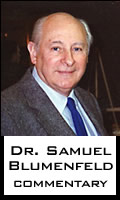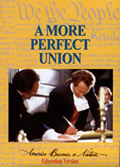Other
Blumenfeld Articles:
The Boom in Home School Conventions
Sex Ed And The Destruction Of American Morality
By Samuel Blumenfeld
September 5, 2006
NewsWithViews.com
I don�t go to the movies much these days. But I did see �United 93� and �World Trade Center� because they presented a positive view of Americans dealing with incredibly difficult circumstances which have impacted the lives of all of us. The Islamic terrorist attack on the Twin Towers was an attack on all of us.
But then, for some unfathomable reason, I also went to see �The Devil Wears Prada.� It was on a whim, and I had no idea what the movie was about. But I was intrigued by the title because it suggested sophisticated subject matter. I had seen Prada ads in glossy magazines. The models always looked sick, drugged, or depressed. It was a cult of ugliness parading as high fashion.
But the film was a great surprise. I enjoyed it so much that I went to see it twice. The story is from a novel by a young writer, Lauren Weisberger, who tells a tale of what it was like to work for an impossible boss, the editor of a great fashion magazine. It is a roman a clef, and anyone in the New York fashion field would know whom she was writing about.
However, the film rises far above the novel in every way. First, the magazine editor, Miranda Priestly, is played by the incomparable Meryl Streep. She�s a very demanding boss, but she also represents some very positive values: intelligence, savoir-faire, creativity, and responsibility. Streep creates a character as unforgettable as Scarlet O�Hara. Anne Hathaway plays Andrea Sachs, the midwestern girl right out of college, who comes to New York seeking her fortune and winds up working for Miranda. But in the end Andrea becomes disillusioned with the glamorous but dog-eat-dog world of high fashion, deserts her boss at a crucial media moment and dumps her cell-phone in a Paris fountain. The little snot then returns to her down-to-earth sous-chef of a boyfriend�Mr. Philosophy 101�and tells him how right he was about everything.
But the main character of this movie is not Miranda Priestly, but the fabulous city of New York, the glittering island of Manhattan, the greatest, most glamorous city ever created in the history of civilization. The photographic sweeps over Manhattan in brilliant sunlight and also at night with its lights and sleek automobiles tell the story of a civilization so rich, so technologically advanced, so dazzling, so powerful, that Islamic terrorists could bring down the gigantic Twin Towers without crippling the city.
The beauty of Miranda Priestly is that she represents the American woman in all her liberated glory, ruling the fashion world with decisive finesse. Fashion is very much at the heart of Western civilization and secular culture. Paris, New York, London are the arbiters of what everyone will wear just about everywhere except in the dark recesses of the Islamic world. There, women wear the burka, a symbol of inferiority and enslavement. The burka represents a barbaric state of mind that stifles the Islamic world and baffles the West. Polly Toynbee wrote in The Guardian after the liberation of Afghanistan:
The top-to-toe burka, with its sinister, airless little grille, is more than an instrument of persecution, it is a public tarring and feathering of female sexuality. It transforms any woman into an object of defilement too untouchably disgusting to be seen.
Thus, you can safely bet that no one, not even a sword-wielding Islamofascist threatening to cut her head off, could ever force Miranda Priestly to wear a burka!
If there is a clash of civilizations, it is between the glamorous, liberated fashion world of the West and the dismal, enslaving world of the burka. Stanley Kurtz wrote in the National Review: �The conflict between modernity and the traditional Muslim view of women is one of the most important causes of this war.�
The purpose of American military power is to protect the freedom of the Miranda Priestlys of our world so that they can express beauty and creativity without fear of the enemy. It is the duty of American men to protect American women�intelligent, creative, and nurturing.
Also, I did not detect a vulgar word or expression during the entire film. And equally impressive were the scenes made on location in New York, in which Andrea dodges taxis or walks through crowds. Everything is authentic. The scenes in Paris were equally authentic in every detail. The director, David Frankel, took great pains to make every scene as real and true as possible.
|
Subscribe to the NewsWithViews Daily News Alerts! |
Obviously, Frankel loves New York and knows the city. He is the son of Max Frankel, executive editor of The New York Times. He went to Hollywood to write TV sitcoms and make movies. When one reads the credits at the end of this movie, one gets just a small idea of what it takes to produce a film of this kind. It was a major cultural and technological undertaking, and in this case the result is brilliant and exhilarating.
� 2006 Samuel Blumenfeld - All Rights Reserved
Sign Up For Free E-Mail Alerts
E-Mails
are used strictly for NWVs alerts, not for sale
Samuel L. Blumenfeld is the author of eight books on education, including �Is Public Education Necessary?� and �The Whole Language/OBE Fraud,� published by The Paradigm Company, 208-322-4440. His reading instruction program, �Alpha-Phonics,� is available by writing The Tutoring Company, P.O. Box 540111, Waltham, MA 02454-0111.
E-Mail:
slblu@netway.com
Websites: www.alpha-phonics.com
and
www.howtotutor.com
If there is a clash of civilizations, it is between the glamorous, liberated fashion world of the West and the dismal, enslaving world of the burka.









